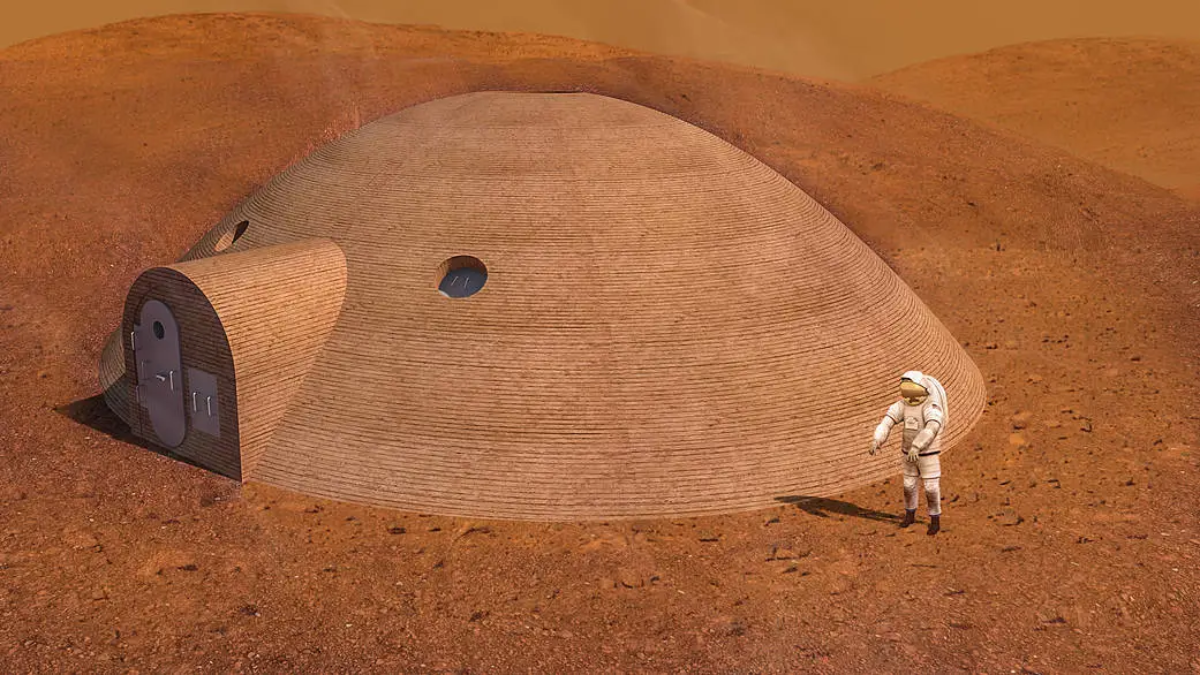As humanity inches closer to realizing the dream of Mars colonization, the challenge of building sustainable habitats on the Red Planet takes center stage.
Scientists have proposed a novel solution: using human blood to create a protein-enhanced cement, dubbed AstroCrete. Inspired by ancient Roman construction techniques, this innovation could revolutionize space architecture but raises significant ethical and practical concerns.
Building with Martian Dust and Human Fluids
Transporting construction materials to Mars is nearly impossible due to its distance—62 million kilometers from Earth—and the enormous costs involved. To overcome this challenge, scientists propose harnessing local resources and settlers’ own biological materials to construct habitats.
Researchers from the University of Tehran have explored the use of Martian regolith, the loose soil and rocks found on Mars, combined with serum albumin extracted from human blood plasma.
The result is AstroCrete, a protein-enhanced cement that offers remarkable durability. Laboratory tests reveal that AstroCrete is 300% stronger than other Martian concrete alternatives.
Read : Rare Sulphur Stone Discovered on Mars by Curiosity Rover
This concept finds historical resonance in the ancient Romans, who reportedly used animal blood in their mortar to enhance its properties. Drawing from this age-old technique, AstroCrete represents a modern adaptation designed for the challenges of extraterrestrial construction.
Read : Mysterious ‘Hole’ on the Flank of an Ancient Volcano on Mars Could Shelter Humans: Research
Beyond blood, other bodily fluids such as urine, sweat, and tears could also contribute to construction. These fluids contain carbamide, a compound that enhances the binding properties of the cement, allowing settlers to create durable and adaptable structures using readily available resources.
Benefits and Ethical Concerns
AstroCrete presents several advantages for establishing Martian colonies:
- Resource Efficiency: By utilizing materials available on Mars and within settlers themselves, the need to transport heavy and costly construction supplies from Earth is minimized.
- Adaptability: This approach allows for on-demand construction of shelters tailored to specific needs, offering flexibility in harsh Martian environments.
- Strength and Durability: AstroCrete’s remarkable strength ensures that habitats can withstand Mars’ extreme weather conditions, including intense dust storms and temperature fluctuations.
However, the method also presents significant ethical and health-related challenges. Extracting blood and other bodily fluids frequently could weaken settlers, leading to health complications such as anemia, fatigue, and a weakened immune system. The psychological toll of constant bodily fluid donations could also affect the mental well-being of pioneers.

Ethically, the concept raises questions about the limits of human sacrifice for scientific advancement. Is it acceptable to use settlers’ bodies as resources for construction? How would such practices align with international space laws and human rights principles?
Alternative Solutions to AstroCrete
While AstroCrete offers a bold vision for Martian settlement, other approaches are being explored to address the challenges of building in space:
- In-Situ Resource Utilization (ISRU): ISRU focuses on extracting and utilizing local Martian resources, such as water ice or sulfur, to create construction materials. This method reduces reliance on Earth-based supplies while avoiding the ethical dilemmas associated with AstroCrete.
- Bioengineered Solutions: Researchers are investigating the use of microbes to produce biocement. These microorganisms can bind Martian regolith into solid structures, offering a sustainable and ethical alternative to using human-derived materials.
- 3D Printing Technologies: Robotic systems equipped with 3D printing capabilities can use regolith-based compounds to construct habitats. This method leverages automation to reduce human involvement in hazardous construction tasks.
Each of these alternatives comes with its own set of challenges, including technological limitations and the need for extensive testing. However, they offer pathways to sustainable Martian construction without relying on human biological resources.

The proposal to use human blood and other bodily fluids to create AstroCrete for Martian construction is a testament to human ingenuity and determination. Drawing inspiration from ancient Roman techniques, this approach leverages available resources to address the logistical challenges of building on Mars.
However, the method’s ethical implications and health risks cannot be ignored. As researchers continue to explore innovative solutions, a balance must be struck between practicality, sustainability, and respect for human dignity.
As humanity prepares to take its first steps toward settling Mars, pioneers may face unprecedented sacrifices. Whether through blood, sweat, or technology, the journey to the Red Planet will undoubtedly redefine the limits of human endurance and ingenuity.
let’s enjoy few years on earth with peace and happiness….✍🏼🙏

